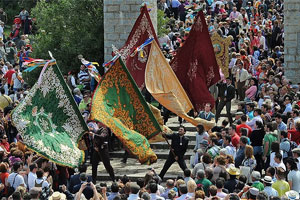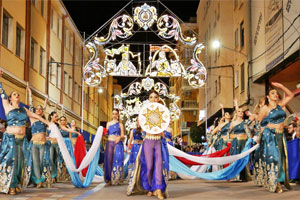The Bujots Massacre

What does the Matanza de Bujots consist of?
The Matanza de Bujots, also known as Matanza de Monigotes, is a traditional festival that is celebrated in the city of Ciutadella, Menorca, on Easter Sunday. In this festivity, different associations of the city hang straw monigots, known as Bujots, on the balconies, which usually represent public figures from politics and society in general, and are often used to make criticisms and demands.
On the day of the celebration, four or five people armed with shotgun blanks go out into the street to shoot down these dolls and burn them afterwards. It is believed that this tradition originated to ward off evil spirits.
Although the exact origin of this tradition is not known, it is believed that it comes from an ancient custom in which they would take a dummy for a walk through the streets of Ciutadella, which they would then burn in the Plaça des Born. It is speculated that this was a festive way to end Lent, a time of darkness and deprivation.
The monigotes are prepared by different entities and associations before Easter Sunday and are kept secret until they are hung in the streets. The monigotes carry a sign that wittily explains the reason for the mockery.
The cartridges used in this celebration are specially prepared in a factory in Maó and are blanks. They are fired with shotguns with blanks, and around three hundred shots are fired by four or five shooters for each monigote.
The celebration begins around midday with a deafening noise of gunfire and does not end until the straw man is shot down by the gunpowder and falls to the ground in flames, which can take about ten minutes.
With this curious tradition, the people of Ciutadella leave Lent purified and safe from bad omens. The Matances de Bujots is a festivity that attracts many tourists and visitors every year and has been part of the island's culture for a long time.
What to see in Ciutadella
Ciutadella is a city full of history, culture, and beauty on the island of Menorca, Spain. Here are some of the most outstanding places you should visit in this city:
- Cathedral of Santa Maria: It is one of the most important monuments in Ciutadella. It was built in the 13th century in Gothic style and is known for its impressive rose window.
- Port of Ciutadella: It is a charming and lively place. Along its promenade, there are numerous restaurants, bars, and shops. It is also possible to hire boat excursions to explore the coast of Menorca.
- Old town: The historic center of Ciutadella is a true gem of architecture and history. Its cobbled streets, squares, and historic buildings transport the visitor to another era.
- Plaça des Born: It is the main square in Ciutadella and is surrounded by historic buildings and restaurants. In the center of the square, there is a commemorative obelisk.
- Diocesan Museum: It is a museum located in the former episcopal palace that exhibits a wide collection of sacred art.
- Castell de Sant Nicolau: It is a fortress built in the 18th century that offers impressive views of the city and the sea.
- Mirador de Sa Font Santa: This viewpoint is located about 2 km from the center of Ciutadella and offers a spectacular panoramic view of the coast and the city.
- Beaches: The beaches surrounding Ciutadella are spectacular, with crystal-clear waters and white sands. Among the most outstanding are Cala en Turqueta, Cala Macarella, and Cala Macarelleta.
These are just some of the most outstanding places in Ciutadella, but there are many others that are also worth visiting. The city offers a great variety of cultural, leisure, and gastronomic activities, making it an ideal destination for any type of traveler.
In addition, there are unique megalithic monuments in the surrounding area, such as the Taulas, which are also worth seeing and visiting.
The Taulas of Menorca
The Taulas are megalithic constructions that are characterized by having two large stone blocks placed vertically, supporting a horizontal slab on top. These structures were found in enclosures surrounded by large stones and are believed to have been used in religious ceremonies of the Talayotic culture, which inhabited Menorca from 2000 BC until the arrival of the Romans in the 2nd century BC. The Taula de Torralba site, located about 15 km from Ciutadella, is one of the most representative and best-preserved on the island.
The Naveta de Tudons is another megalithic construction that stands out for its uniqueness and rarity. This collective tomb was built with large stone blocks without mortar and has the shape of an inverted boat. It is located about 10 km from Ciutadella and is believed to have been built around 1000 BC and used for burials until the 7th century BC. The Naveta de Tudons is one of the most emblematic monuments of the Talayotic culture and has been declared a Cultural Heritage Site.
Visiting these megalithic constructions is a unique and impressive experience that you cannot miss if you are visiting Ciutadella or Menorca in general. Moreover, they are a testament to the rich historical and cultural heritage of the island.
Here are some of the most important locations to see taulas in Menorca:
- Torralba d'en Salort: This is the most well-known place to see taulas in Menorca. It is located near the town of Alaior, in the center of the island.
- Trepucó: Located on the outskirts of Mahón, on the road to the town of Sant Lluís, is the prehistoric settlement of Trepucó, where taulas can also be seen.
- Talatí de Dalt: On the outskirts of Mahón, on the road to the town of Es Castell, is the prehistoric settlement of Talatí de Dalt, where taulas can also be seen.
- Son Catlar: It is located in the south of the island, near the town of Ciutadella. This is one of the largest prehistoric settlements in Menorca and also has taulas.
- Naveta des Tudons: Although it is not a taula, the Naveta des Tudons is a megalithic construction from the Talayotic period that is also very interesting to visit. It is located near Ciutadella, on the road to Cala en Blanes.
These are some of the most important locations to see taulas in Menorca. There are other archaeological areas on the island that also have taulas, but these are the most popular and best preserved.
What to eat in Ciutadella
Ciutadella is a city with a rich gastronomic tradition, in which its dishes of fresh fish and seafood stand out, as well as some typical preparations of Menorcan cuisine. Some of the dishes that you cannot miss if you visit the city are:
- Caldereta de langosta: one of the most representative dishes of Menorcan cuisine, it is a stew made with lobster, potatoes, tomato, pepper, garlic, and other vegetables and spices.
- Seafood rice: another classic of Mediterranean cuisine, in this case prepared with a variety of fresh seafood, such as prawns, mussels, squid, among others.
- Sobrasada: a typical sausage of the island, made with pork, paprika, and other spices. It is usually eaten spread on toast.
- Mahón cheeses: the island of Menorca is famous for its cheeses, especially Mahón cheese, which is made with raw cow's milk and is characterized by its strong and slightly spicy flavor.
- Pastissets de Ciutadella: typical sweets of the city, made with a puff pastry dough filled with angel hair and sprinkled with powdered sugar.
In addition, if you visit the city during the Sant Joan festivities (June), you can try the cocas de Sant Joan, typical sweets that are prepared with a dough of flour, lard, and sugar, and are filled with cream, angel hair, almond or candied fruit.





